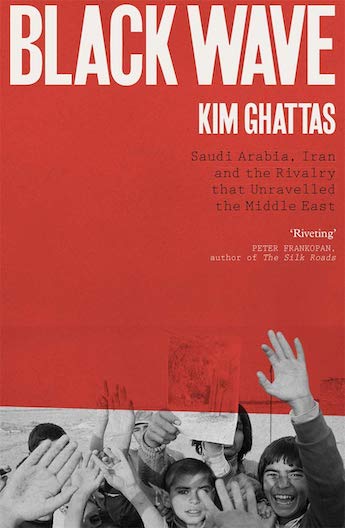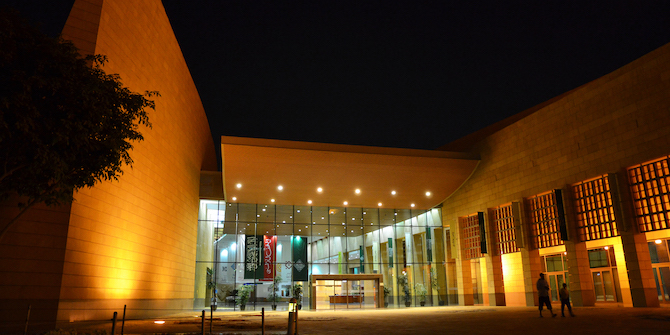by Marc Martorell Junyent
Kim Ghattas’ second book, Black Wave: Saudi Arabia, Iran and the Rivalry that Unravelled the Middle East, starts with an unambiguous question: ‘What happened to us?’ (p.1). The Emmy award-winning journalist and writer, born and raised in Lebanon, aims at understanding when and why sectarian killings, religious zealotry and amorphous wars spread in the Arab and Muslim world. Ghattas’ question does not sound very different from that posed by the historian Bernard Lewis in his book What Went Wrong? The Clash Between Islam and Modernity in the Middle East, published in the aftermath of the 9/11 attacks. Lewis’ subtitle already gives us a glimpse of the condescending Orientalism to be found in the pages of his book. Far from that, Ghattas takes an approach unburdened by any pre-conceived and paternalistic vision of the Middle East.
Searching for an answer to her initial question, she resorts to archives, newspaper articles and scholarly works. More remarkable, however, is the number and variety of interviews she conducted, some of them with high-profile personalities such as Saudi Prince Turki al-Faisal, Tunisian Ennahda Party leader Rached Ghannouchi or the late Saudi journalist Jamal Khashoggi. The conversations with Khashoggi, who was ‘incredibly generous in sharing his story, imparting knowledge, and responding to endless follow-ups’ (p.362), provided Ghattas with a privileged perspective to write about his brutal killing in Istanbul in the last chapter of the book, ‘Murder on the Bosporus’.
It is worth stating what Ghattas’ work, in her own words, is not. She writes that ‘although this is neither a work of historical scholarship nor an academic study, it is more than a reported narrative’ (p.3). Some of the weaknesses of the book may be related to this. Even though the author includes references at the end of the book, they are sometimes quite scarce and difficult to navigate. We observe an example of this when she explains that ‘at least three thousand political prisoners’ were executed in 1988 by the Islamic Republic. While this assertion is well-referenced, the same does not apply to the following sentence, far more contentious, stating that ‘some reports put the number much higher, up to thirty thousand’ (p.78). Horrible as it was, the 1988 massacre is very unlikely to have reached these proportions. Amnesty International, who reported the events in detail already in 1990, published two years ago a thorough re-examination of this tragic moment in Iranian history. The international NGO concludes that ‘minimum estimates put the death toll at around 5,000’. While adding that ‘the real number could be higher’, it would still be far away from thirty thousand victims.
The strength of Black Wave lays in Ghattas’ gift for narrative writing, in her ability to grasp the attention of the reader and prove that a non-fiction book can also be a page-turner. She strikes the perfect balance between describing the broader trends in the Middle East and presenting the lives of the individuals shaped by them, moving from one dimension to another with ease. The best example of this may be found in Chapter 3, ‘Bleeding Heart’, which describes the seizure of the Grand Mosque in Mecca in 1979 by a group of militant radicals calling for the overthrow of the Saudi monarchy. For this chapter, Ghattas interviewed Sami Angawi, a Saudi architect living in Mecca in 1979. We get to know about his uneasiness with the effects of oil wealth on Saudi cultural heritage in the years prior to the seizure of the mosque. Moreover, we read that he provided floor plans and aerial photographs to the Saudi authorities hoping the mosque could be retaken with limited violence – to no avail. After the recapture of the Grand Mosque, he could not help but feeling anguished with the violent turn of events.
The seizure of the Grand Mosque in Mecca was followed by one of the two Islamic revolutions that took place in 1979: the one ‘that unfurled almost unnoticed’ in the Saudi kingdom as opposed to the one ‘that made world headlines’ – the Iranian revolution (p.71). The revolution in Saudi Arabia was marked by the gradual expansion of Salafist puritanism and thus more difficult to detect. But both would, Ghattas notes, dramatically reshape their countries of origin and bring with them a wake of darkness and oppression in the Arab and Muslim world. 1979’s third seminal event was the Soviet invasion of Afghanistan. Even though any clear-cut division between different historical periods entails a certain element of arbitrariness, Ghattas clearly has a good case for pointing at 1979 as the origin of what she calls the ‘Black Wave’.
The term is used by the author, probably too vaguely, to describe how the Saudi-Iranian rivalry for Islamic legitimacy ‘unleashed sectarian identities and killings’ in the broader Middle East (p.2). Her book is a trip across time and space, moving from Egypt in the late 1970s to Pakistan and Lebanon in the 1980s, and onwards. The inclusion of Pakistan in the narrative brings a refreshing perspective. Despite often being excluded from works focusing on the Middle East, Ghattas aptly shows how the country was affected by the Saudi-Iranian rivalry.
The shortcomings of the book are compensated by its vivid descriptions and engaging style of writing. It is also worth noting that the fact that Black Wave covers different periods of time and countries must have surely complicated the work of the writer. However, the result is a region-wide perspective enriched by dozens of interviews that makes a decisive contribution to our understanding of these decades. Her unrivalled access to sources and sense of narrative contribute to the uniqueness of Ghattas’ work.








very good but wrong title – it is about the islamic world and their chaotic greedy ambitions. Not black.
Saudi Family is a recent construct and totally corrupt while Iran is ready to socially explode.
The author would have done better to declare Islam to be a fake religion- as it is based on totalitarian fascist dictatorship rules brainwashing and blackmailing dumb gullible muslims. Islam promises muslim men sex and uses sharia law to control muslim women. The islamic world will collide and Turkey will take sides with Iran but there is no allah! The author has done well to describe the last 40 years of islamic upheavel but does not condemn Saudi OBL or Pakistans protection of him or Pakistans involvement in Afghanistan the Taliban and poppy farmers smuggling heroin into Europe to boost the bankrupt state of Pakistan. The fact is there is no allah while the muslims are committing crimes of drug dealing and rape and child abuse and prostitution against the infidels in the name of the non existent allah. Time to condemn Islam and the muslims as common criminals that should be wiped out as they fully intend to do to the non muslims. There is plenty of evidence facts and videos of the violent murders carried out by the muslims whatever the sect, to condemn and wipe out the islamic states at the earliest opportunity.